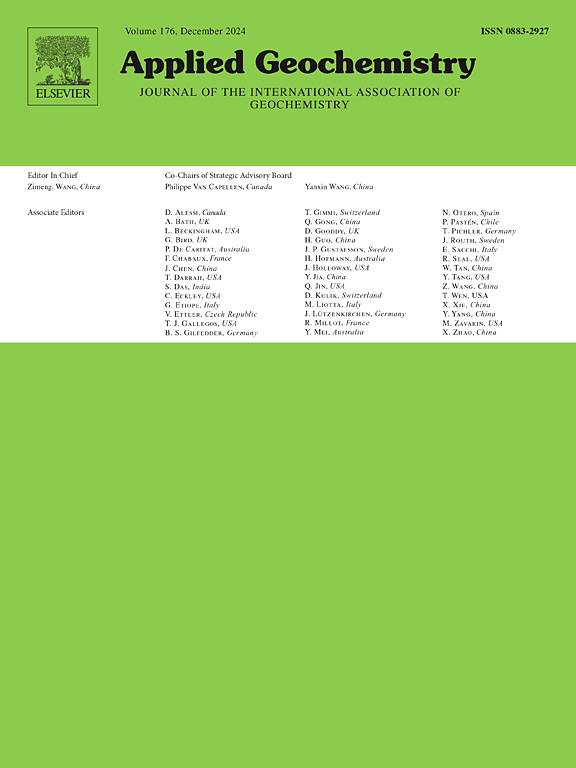稀土元素在华南不同气候区花岗岩化学风化过程中的行为
IF 3.1
3区 地球科学
Q1 GEOCHEMISTRY & GEOPHYSICS
引用次数: 0
摘要
花岗岩腐殖岩是稀土元素的重要寄主,特别是在华南地区。阐明花岗岩风化过程中稀土元素的迁移和分馏机制,有助于对稀土矿床进行深入有效的研究。本文综合分析了两个花岗岩剖面在不同气候条件下的大块样品中稀土元素的含量和分布规律。在这两条剖面中,稀土元素浓度随深度增加,表明稀土元素向下迁移(受地表酸性条件的促进),在底部富集。稀土元素在风化剖面中的分布与矿物组成(如粘土矿物和铁氧化物在承载稀土元素中的作用)密切相关。此外,矿物学对稀土分选也起着至关重要的调节作用,而其他因素对稀土分选的影响是次要的。大量高岭石和伊利石分别优先吸附hree和lree;因此,强烈风化的HZ剖面在温暖湿润的气候中发展,呈现出向底部升高(La/Yb)N的特征。相比之下,考虑到其不同的矿物组成,干燥和寒冷条件下WMS剖面的(La/Yb)N模式相似,是绿泥石或OM优先保留hree和表观剥蚀释放大量lree的结果。此外,两个剖面在近地表均表现出明显的正Ce和Eu异常,其中HZ剖面的异常更为严重。相对于WMS剖面(28%,1.06±30,N = 19, 1sd), HZ剖面受极端风化过程中形成的块状粘土矿物控制,REE迁移明显(风化过程中REE损失61%),La/Yb N(1.24±1.15,N = 15, 1sd);不同矿物组成的WMS剖面化学风化不完全,稀土元素行为受多种因素影响。本文章由计算机程序翻译,如有差异,请以英文原文为准。
Behavior of rare earth elements during the chemical weathering of two granite profiles in different climatic regions of southern China
Granite saprolites are important hosts of rare earth elements (REE), especially in southern China. The elucidation of REE's migration and fractionation mechanisms during granite weathering allows researchers to thoroughly investigate REE deposits efficiently. This study comprehensively analyzed REE contents and distribution patterns in bulk samples obtained from two granite profiles, exposed to different climatic conditions. In both profiles, REE concentrations increased with depth, indicating downward migration (facilitated by the acidic conditions near the surface) and significant enrichment of REEs at the bottom. The distribution of REEs in the weathering profiles is highly related to mineralogical compositions (such as the role of clay minerals and Fe oxides in hosting REEs). Moreover, mineralogy also plays a crucial role in modulating REE fractionation while others affect secondarily. Substantial amounts of kaolinite and illite preferentially adsorb HREEs and LREEs, respectively; thus, the intensively weathered HZ profile, developing in a warm and humid climate, presents elevating (La/Yb)N toward the bottom. In contrast, considering its distinct mineralogical compositions, the similar patterns of (La/Yb)N of the WMS profile in dry and cold conditions, result from preferential retention of HREEs by chlorite or OM and significant LREEs release via epigenetic denudation. In addition, both profiles exhibited significantly positive Ce and Eu anomalies near the surface, with those in the HZ profile being more severe. The HZ profile, being exposed to warm and humid conditions, was characterized by more pronounced REE migration (61% losses of REEs during weathering) and significant (La/Yb)N (1.24 ± 1.15, n = 15, 1sd) than the WMS profile (28% losses, 1.06 ± 30, n = 19, 1sd), which were predominantly controlled by massive clay minerals formed during extreme weathering; correspondingly, the WMS profile, with different mineralogical compositions, experienced less complete chemical weathering, wherein REE behavior would be affected by multiple factors.
求助全文
通过发布文献求助,成功后即可免费获取论文全文。
去求助
来源期刊

Applied Geochemistry
地学-地球化学与地球物理
CiteScore
6.10
自引率
8.80%
发文量
272
审稿时长
65 days
期刊介绍:
Applied Geochemistry is an international journal devoted to publication of original research papers, rapid research communications and selected review papers in geochemistry and urban geochemistry which have some practical application to an aspect of human endeavour, such as the preservation of the environment, health, waste disposal and the search for resources. Papers on applications of inorganic, organic and isotope geochemistry and geochemical processes are therefore welcome provided they meet the main criterion. Spatial and temporal monitoring case studies are only of interest to our international readership if they present new ideas of broad application.
Topics covered include: (1) Environmental geochemistry (including natural and anthropogenic aspects, and protection and remediation strategies); (2) Hydrogeochemistry (surface and groundwater); (3) Medical (urban) geochemistry; (4) The search for energy resources (in particular unconventional oil and gas or emerging metal resources); (5) Energy exploitation (in particular geothermal energy and CCS); (6) Upgrading of energy and mineral resources where there is a direct geochemical application; and (7) Waste disposal, including nuclear waste disposal.
 求助内容:
求助内容: 应助结果提醒方式:
应助结果提醒方式:


